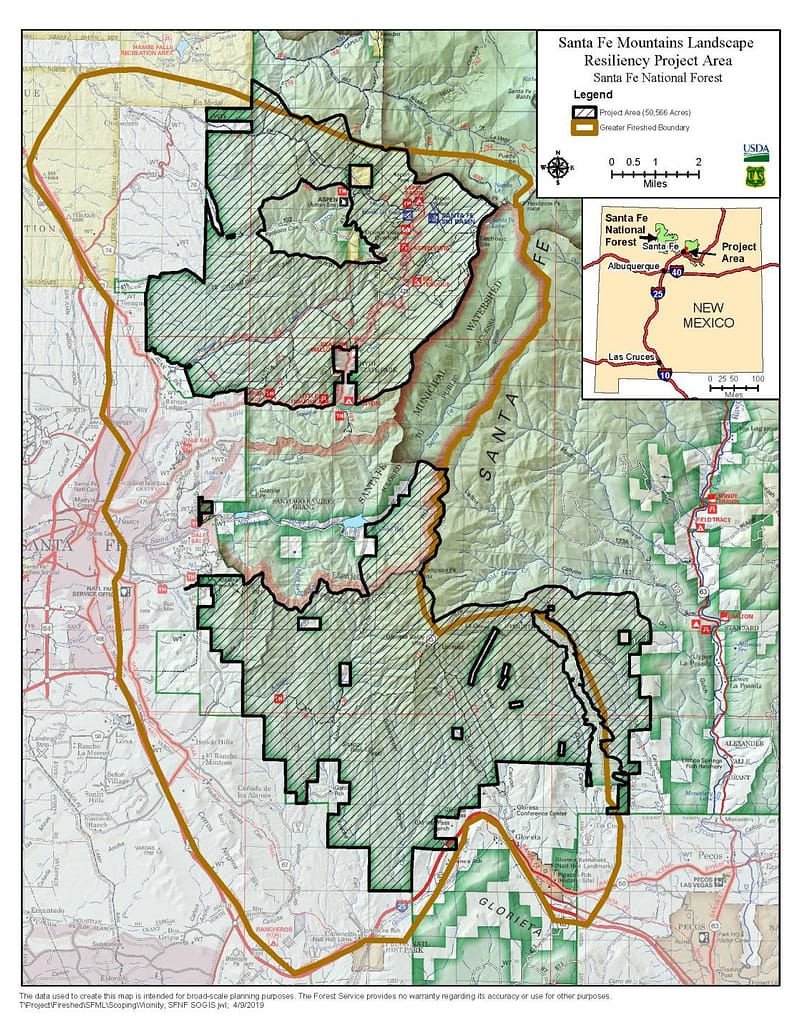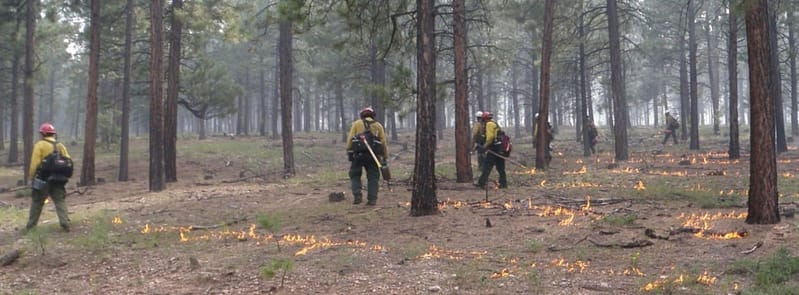The Santa Fe Mountains Project
by The Forest Advocate May 30, 2020, updated September 13, 2023
The Santa Fe Mountains Landscape Resiliency Project, or Santa Fe Mountains Project, was by far the largest thinning and prescribed burning project ever proposed for the forest directly outside of Santa Fe. The Forest Service proposed to cut the majority of trees on up to 28 square miles, and to repeatedly burn up to 59 square miles within a 50,566 acre project area, which abuts Santa Fe and surrounding communities. The maximum size tree to be cut was proposed to be 24” diameter at breast height, which are some of the largest trees in the project area. The stated purpose of the project is to increase forest health and to reduce the risk of catastrophic wildfire.
Past projects have left behind damaged, barren and dried out ecosystems lacking ecological integrity, and the natural beauty of these large sections of our fragile forest have been highly compromised. The frequent prescribed burn smoke has become an increasingly serious health hazard to the public.
Over 5,000 members of the public and organizations submitted written comments to the Forest Service about the project’s scoping document in 2019, and over 98% of these comments were critical of the project as proposed. Almost all of the comments called for an Environmental Impact Statement to be completed before project work begins.
In the past, the Forest Service had produced Environmental Impact Statements for much smaller and less impactful projects, as is required by the National Environmental Policy Act (NEPA). Also in the past, the Forest Service had made public comments on their projects available to the public.
This time, however, despite the size and scope of the Santa Fe Project, the Forest Service stated that an Environmental Impact Statement was not likely to be necessary. They also chose not to make the project scoping comments available to the public, except for posting a small number for a few weeks before taking them down.
It was necessary for The Forest Advocate to make a request under the Freedom of Information Act (FOIA) in order to obtain the public comments, and the Forest Service has never provided a way for the public to view most of the 5,000+ comments which they received.
In the interest of transparency, The Forest Advocate published the comments obtained under FOIA so that the public could understand the Santa Fe Project as thoroughly as possible. You may view the comments here.
In September of 2021, the Forest Service released the draft environmental assessment, which was its updated proposal for the project, along with limited analysis. The purpose of an environmental assessment is to determine if comprehensive analysis, an Environmental Impact Statement (EIS), is required for the project. An EIS is required when a project may have a significant effect on forest resources, or have a significant effect on the human environment which is controversial.
The draft environmental assessment outlined, in only a very general way, the types of thinning and burning treatments that were proposed to be implemented. There was no site-specific information, so it was unknown where treatments might be done within the project area, nor were there any real specifics about how many or what size trees will be cut. The document stated that no trees above 16” would be cut, but the majority of trees in the Santa Fe National Forest are smaller than 16”, so it still placed little limitation on the size of trees that can be cut. However, it is very significant that the larger trees will be preserved, and that was due to conservation organizations and the publics’ efforts to preserve the forest outside of Santa Fe. The document stated that thinning methods would include both hand-crews using chainsaws and heavy equipment such as masticators and buncher-fellers. No information was provided about how treatments would be carried out in the Roadless Areas making up much of the project area.
The official 30 day public comment period for the draft environmental assessment began on September 30, 2021 and ran through October 29, 2021. The Forest Advocate posted a short guide for quick comments and a more comprehensive guide for longer comments. On October 9, The Forest Advocate hosted a community event, Protecting Our Forest, Our Community and Our Health, with conservation scientist Dominick DellaSalla as the featured speaker. The purpose of the event was explain the project to the public and to help the public understand how to write environmental assessment comments.
121 individuals and organizations submitted draft environmental assessment comments, and the great majority opposed the project as proposed and requested that an EIS be completed for the project. This time, the comments were posted in the Forest Service reading room.
The Santa Fe area community and anyone else interested were invited by the Santa Fe County Commission, WildEarth Guardians and The Forest Advocate to a Zoom “listening session” on November 10, 2022 — Living With Wildfire. Forest Service officials, Santa Fe Fireshed Coalition members and elected representatives and/or their liaisons attended, along with representatives of conservation organizations and members of the public. The community and representatives from conservation organizations spoke powerfully on the impacts the Santa Fe Mountains Project would likely have on the local forest and community, and made recommendations for strategies for a better project, that supposed the forest and communities. A few also spoke in support of the project as proposed.
On December 9, 2022, the Draft Decision Notice and Finding of no Significant Impact was released. The Draft Decision was to go forward with the project as proposed without significant modifications from the proposed action in the draft environmental assessment. The Forest Service determined that no significant impacts would occur from implementation of the project. This decision was greatly disagreed with and opposed by members of the public and conservation organizations.
The agency provided responses to the draft environmental assessment comments. Generally the responses only reiterated what was already contained in the environmental assessment.
The objection period, the time when individuals and organizations who do not agree with the project decision can request changes to the decision, commenced in late March of 2022 and ended on May 12, 2022. 21 objections were submitted. Only the objections by individuals and organizations that had “standing,” meaning that they had previously submitted a comment about the project, would be considered by the Forest Service. Also, the process of submitting objections was fairly precise and rigorous, and only some of the objections submitted were deemed as acceptable and valid by the Forest Service. The Forest Advocate submitted a joint objection with WildEarth Guardians and the Santa Fe Forest Coalition. The Forest Advocate also submitted a separate objection concerning the health impacts of prescribed burn smoke.
During the objection period, two Forest Service prescribed burns went out of control and precipitated the largest wildfire in New Mexico history — The Hermits Peak/Calf Canyon Fire. The Hermits Peak Fire started on April 6, 2022 and was caused by a broadcast prescribed burn that was ignited during a high spring wind pattern in the Santa Fe National Forest near Las Vegas, New Mexico. The Calf Canyon Fire erupted a few miles away, just three days later, on April 9, and was ignited by the Forest Service losing containment of pile burns from thinning operations.The two fires merged into one fire. The Forest Service did not disclose the origin of the Calf Canyon Fire until months later. The fires destroyed several hundred homes and damaged hundreds more, and entire communities were devastated. Many residents were displaced. The Las Vegas water system was damaged by silt from the fire, and acequias and roads washed out. Three people died in post-fire flooding.
Another fire broke out in the Jemez Mountains, named the Cerro Pelado Fire. The Forest Service announced, over a year later, that this fire was also caused by escaped pile burns.
These fires were traumatic events for the communities nearby the Santa Fe National Forest, and for the general public. Outrage was expressed by both members of the public and elected representatives. On July 12, 2022, the Santa Fe Board of County Commissioners passed Resolution # 2022-050, urging the US Forest Service to complete an Environmental Impact Statement for the project and to utilize a broad range of the best available current science. They also urged the Forest Service to stop implementing prescribed burns on the Santa Fe National Forest until a thorough review had taken place.
On July 26, 2022, the SFNF withdrew the draft decision notice and finding of no significant impact(FONSI) for the Santa Fe Mountains Landscape Resiliency Project (SFMLRP) due to the need to focus on fire suppression activities for the Hermits Peak-Calf Canyon and Cerro Pelado Fires, and also possibly due to the general chaos and public anger generated by the fire. This withdrawal also terminated the objection process. The withdrawal letter stated, “The SFNF is taking this step to reengage with our partners and community on this very important project to improve forest health in and around Santa Fe.” Very little outreach appeared to have occurred.
On December 9, 2022, Acting Forest Supervisor James Duran released a letter, informing all interested parties that the objection process would be reinitiated. The objections that had been submitted previously had been withdrawn from consideration, and those who chose to object were required to submit new objections. The objection deadline was Jan. 23, 2023. This time, 18 objections were submitted, and The Forest Advocate again submitted a joint objection with WildEarth Guardians and the Santa Fe Forest Coalition.
See all objections from both objections periods here.
The Forest Service chose not to hold objection resolution meetings during either objection period. Some conservation organizations requested to have individual objection resolution meetings, but were refused, as the Forest Service contended that there were no significant objections that they were required to consider.
In May of 2023, the Santa Fe Mountains Landscape Resiliency Project Final Decision Notice and Finding of No Significant Impact was made public. There were no significant changes from the Draft Decision Notice and Finding of No Significant Impact. No consideration was made of the two escaped prescribed burns that caused the 341,000 acre Hermits Peak/Calf Canyon Fire. There was no analysis that considered the potential for prescribed burn escapes during implementation of the Santa Fe Mountains Project, even though the project plan is to burn right up to property lines in wildland/urban interface communities.
After the final decision had been released, but before the decision was signed, Forest Supervisor Shaun Sanchez invited the organizations who had requested to have objection resolution meetings to meet with him to share their concerns about the project, and also invited all objectors to a group meeting. Conservation scientist Dr. Dominick DellaSala, along with Sarah Hyden of The Forest Advocate, met with Supervisor Sanchez and two other Santa Fe National Forest officials, and explained that implementation of the project decision would likely cause ecological damage to the project landscape and put communities at risk. They described a more ecologically beneficial approach to the project that could be taken. The Forest Service officials listened to their concerns politely and attentively.
Supervisor Sanchez stated at the meeting that the Forest Service will listen to members of forest communities when carrying out fuels treatments near their communities. The Forest Service has stated this before, but the results of fuels treatment projects in the past have never before significantly reflected what locals communities wanted to occur in their nearby forest.
On May 18, 2023, Supervisor Sanchez signed the Santa Fe Mountains Landscape Resiliency Project Decision.
For more information, see Santa Fe Mountains Project resources
Forest Service map of the Santa Fe Project area — from the Scoping Document:





The Forest Advocate
Santa Fe, New Mexico
